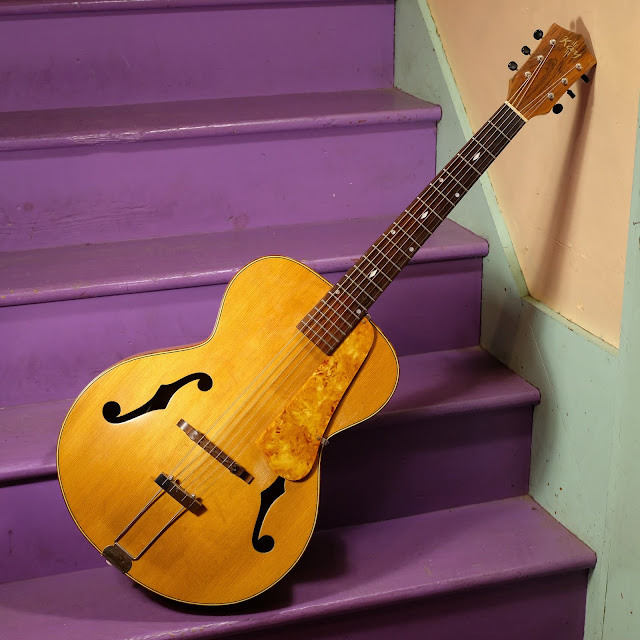1940s Kay Fancy Blonde Archtop Guitar
I've worked on the same basic Kay archtop several times, but none of them were as clean as this one. And -- you know why? Like all old guitars that still have their original cases, it was kept instead of stowed in every depressing corner of every dilapidated barn or cellar you can imagine. This is my sleepily-persuasive argument for having cases for your gear.
This one was brought-in by a local customer and he was hot to get it fixed-up. I knew he was budget-conscious, but like all these old Kays, it had the usual time-destruction -- it needed a neck reset and a warped-neck dealt with. Fortunately, all the other stuff was in good order -- no loose braces, clean finish, and all of its original hardware accounted-for (right down to the bridge thumbwheels which are usually missing).
The owner didn't really want to address the neck in the way necessary (pull the frets, plane the board, and refret), but it really did need that to play right. The warp was over 1/32" overall down the neck and the original frets worn low and thin to begin-with, so just leveling/dressing the board would've meant it would still play like junk.
Fortunately, however, because the neck reset was quick and because Kay slotted their fretboards insanely-deep, I managed to do the work I wanted to do with only a little extra labor time vs. the reset and fret level/dress that was expected. The extra-deep slots meant that I could pull the frets, plane the board and binding without removing the binding or deepening the slots, and then refret with average medium stock (it bends easily so I could hammer the frets in) pretty fast.
The end-result is a killer "trad jazz" box -- it leaps-out with a ton of midrange slap. The neck is slim for the time, fast, and comfortable, and it simply handles like a winner.
Work included: a neck reset, board plane and refret, side dots install, new tuner buttons, compensation to the bridge top/saddle, mild cleaning, and a good setup. It plays bang-on at 3/32" EA and 1/16" DGBE at the 12th fret, strung with 50w-11 gauges. Due to the long 25 3/4" scale and unreinforced neck, I never suggest anything above these gauges on any Kay guitars of this era. Please -- just don't do it. The necks will warp and you'll cry, cry, cry.
Scale length: 25 3/4"
Nut width: 1 11/16"
String spacing at nut: 1 7/16"
String spacing at saddle: 2 3/16"
Nut width: 1 11/16"
String spacing at nut: 1 7/16"
String spacing at saddle: 2 3/16"
Body length: 19 7/8"
Lower bout width: 15 1/2"
Upper bout width: 11 1/4"
Lower bout width: 15 1/2"
Upper bout width: 11 1/4"
Side depth at endpin: 3 3/4"
Top wood: solid spruce
Back/sides: ply flamed maple
Neck wood: poplar
Fretboard: rosewood
Back/sides: ply flamed maple
Neck wood: poplar
Fretboard: rosewood
Neck shape: 14" radius board, slim-medium soft C/V rear
Bridge: rosewood
Nut: original bone
Condition notes: it's clean and entirely original save the side dots and new, black tuner buttons.
The board has tortoise celluloid binding -- just like the body. The inlay on the board is pearl.
So -- the thing about me is that I do sweat a little bit over details. This pickguard's bracket originally had the pickguard aligned a little too close to the edge of the guitar and not quite along the path of the strings. I bent the bracket until it complied and set the pickguard just-so.
Hubba-hubba flamed maple, right? It looks really good in-person, too.
With a little modification, Allparts tuner-buttons go right on the old paddle-style Kluson tuner shafts with help from a small hammer.
I did add a strap button to the heel. The owner seems like the type who might need it.
I'm a fool for tortoise binding against maple.
The original, weirdo endpin is still in place.


















Comments
I've had my fair share of Kays through the shop that I've wanted to bonfire -- and all simply because the necks are squirrely. There's nothing more irritating than necks that just will not function correctly -- because if you're into making these things play right, a good neck is a must. It's the same reason cheap modern Fender-style knockoff guitars/necks are so irritating -- they just aren't stable and never will be.